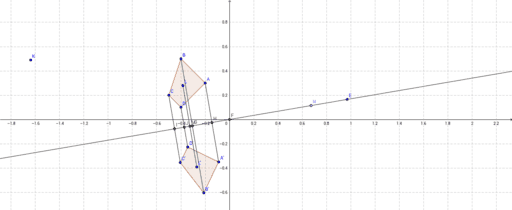


In fact, for two lines L and M,įollowing is a short list of problems that are solved with the help of the reflection transform: Step 2: Extend the line segment in the same direction and by the same measure. The order of reflections matters: two reflections do not commute. Step 1: Extend a perpendicular line segment from C C to the reflection line and measure it. Successive reflections in two axes that meet in a point O is equivalent to a rotation around O through double the angle between them. Successive reflections in two parallel axes result in a translation in the direction perpendicular to the axes to twice the distance between them. Corresponding parts of the figures are the same distance from the line of reflection. To perform a geometry reflection, a line of reflection is needed the resulting orientation of the two figures are opposite. Īll points on the axis of refleclation are fixed as are all the lines perpendicular to the axis. A reflection is an isometry, which means the original and image are congruent, that can be described as a 'flip'. This elementary motion geometry workbook that includes Translations, Reflections and Rotations, / Flips, Turns, Slides, aligns exactly with the Newfoundland and Labrador Grade 5 Math curriculum, and covers other curriculums from across Canada, United States & more This workbook is great for fourth grade, fifth grade and sixth grade students.Using your compass, put the compass needle on your point, set it to intersect your line, and draw an arc. Reflection maps parallel lines onto parallel lines. Draw one arc intersecting your line of reflection.

Reflection is isometry: a reflection preserves distances. Reflection changes the orientation: if a polygon is traversed clockwise, its image is traversed counterclockwise, and vice versa. The following observations are noteworthy:
#Line of reflection geometry install
If you want to see the applet work, visit Sun's website at, download and install Java VM and enjoy the applet. This applet requires Sun's Java VM 2 which your browser may perceive as a popup. In geometry, a reflection is a rigid transformation in which an object is mirrored across a line. They rotate if dragged near the applet's border, or translate if dragged nearer their midpoint. In the applet, you can create polygons with a desired number of vertices, drag the vertices one at a time, or drag the polygon as a whole. On the other hand, if S' is known to be a mirror image of S, then any pair of points P and P' not fixed by the reflection (P ≠ P'), the axes of reflection is uniquely determined as the perpendicular bisector of PP'. To perform a geometry reflection, a line of reflection is needed. This is exactly what has been done in the applet below. reflection notes geometryGeometric transformations 8th grade Math Khan Academy. To determine S L(S) when S is a polygon, suffice it to reflect its vertices. Each point of a given shape S is reflected in L, and the collection of these reflections is the symmetric image of S: S L(S). The reflection transform S L applies to arbitrary shapes point-by-point. So that repeated reflection does noting: it does not move a point.

#Line of reflection geometry how to
If P' = S L(P), then P is the reflection in L of P': P = S L(P'). On this lesson, you will learn how to perform reflections over the x-axis and reflections over the y-axis (also known as across the x-axis and across the y-a. The line L is called the axis of symmetry or axis of reflection. P' is said to be a mirror or symmetric image of P in L. In other words, P' is located on the other side of L, but at the same distance from L as P. Reflection P' of P in L is the point such that PP' is perpendicular to L, and PM = MP', where M is the point of intersection of PP' and L. Note that PC=PC', for example, since they are the radii of the same circle.)Ī positive angle of rotation turns a figure counterclockwise (CCW),Īnd a negative angle of rotation turns the figure clockwise, (CW).Given a line L and a point P. (The dashed arcs in the diagram below represent the circles, with center P, through each of the triangle's vertices. A rotation is called a rigid transformation or isometry because the image is the same size and shape as the pre-image.Īn object and its rotation are the same shape and size, but the figures may be positioned differently.ĭuring a rotation, every point is moved the exact same degree arc along the circleĭefined by the center of the rotation and the angle of rotation. Rays drawn from the center of rotation to a point and its image form an angle called the angle of rotation. When working in the coordinate plane, the center of rotation should be stated, and not assumed to be at the origin. A rotation of θ degrees (notation R C,θ ) is a transformation which "turns" a figure about a fixed point, C, called the center of rotation. The image below shows a shape reflected in a line of reflection.


 0 kommentar(er)
0 kommentar(er)
